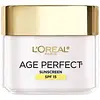What's inside
What's inside
 Key Ingredients
Key Ingredients

 Benefits
Benefits

 Concerns
Concerns

 Ingredients Side-by-side
Ingredients Side-by-side

Phenylbenzimidazole Sulfonic Acid 1.7%
UV AbsorberEthylhexyl Methoxycinnamate 7.5%
UV AbsorberWater
Skin ConditioningCyclopentasiloxane
EmollientGlycerin
HumectantParaffinum Liquidum
EmollientMyristyl Myristate
EmollientStearic Acid
CleansingTriethanolamine
BufferingPalmitic Acid
EmollientAmmonium Polyacryloyldimethyl Taurate
Emulsion StabilisingTitanium Dioxide
Cosmetic ColorantPEG-100 Stearate
Glyceryl Stearate
EmollientMannitol
HumectantPEG-20 Stearate
EmulsifyingStearyl Alcohol
EmollientPhenoxyethanol
PreservativeTocopheryl Acetate
AntioxidantPanthenol
Skin ConditioningCetyl Alcohol
EmollientCapryloyl Salicylic Acid
ExfoliatingAcrylates Copolymer
Butylene Glycol
HumectantAlumina
AbrasiveCyclodextrin
AbsorbentYeast Extract
Skin ConditioningSoluble Collagen
HumectantDisodium Succinate
MaskingScutellaria Baicalensis Root Extract
AstringentMorus Bombycis Root Extract
Skin ConditioningDiazolidinyl Urea
PreservativeMethylparaben
PreservativeButylparaben
MaskingDisodium EDTA
Parfum
MaskingPhenylbenzimidazole Sulfonic Acid 1.7%, Ethylhexyl Methoxycinnamate 7.5%, Water, Cyclopentasiloxane, Glycerin, Paraffinum Liquidum, Myristyl Myristate, Stearic Acid, Triethanolamine, Palmitic Acid, Ammonium Polyacryloyldimethyl Taurate, Titanium Dioxide, PEG-100 Stearate, Glyceryl Stearate, Mannitol, PEG-20 Stearate, Stearyl Alcohol, Phenoxyethanol, Tocopheryl Acetate, Panthenol, Cetyl Alcohol, Capryloyl Salicylic Acid, Acrylates Copolymer, Butylene Glycol, Alumina, Cyclodextrin, Yeast Extract, Soluble Collagen, Disodium Succinate, Scutellaria Baicalensis Root Extract, Morus Bombycis Root Extract, Diazolidinyl Urea, Methylparaben, Butylparaben, Disodium EDTA, Parfum
Water
Skin ConditioningGlycerin
HumectantPrunus Armeniaca Kernel Oil
MaskingAlcohol Denat.
AntimicrobialDimethicone
EmollientHydroxypropyl Tetrahydropyrantriol
Skin ConditioningPropanediol
SolventPropylene Glycol
HumectantIsononyl Isononanoate
EmollientZea Mays Starch
AbsorbentHydroxyethylpiperazine Ethane Sulfonic Acid
BufferingAmmonium Acryloyldimethyltaurate/Steareth-25 Methacrylate Crosspolymer
Emulsion StabilisingAmmonium Polyacryloyldimethyl Taurate
Emulsion StabilisingC13-14 Isoparaffin
EmollientCaffeine
Skin ConditioningCaprylyl Glycol
EmollientCI 42090
Cosmetic ColorantDextrin
AbsorbentDimethiconol
EmollientDisodium EDTA
Eperua Falcata Bark Extract
Skin ProtectingLaureth-7
EmulsifyingMethyldihydrojasmonate
MaskingPentaerythrityl Tetra-Di-T-Butyl Hydroxyhydrocinnamate
AntioxidantPerlite
AbsorbentPhenoxyethanol
PreservativePoloxamer 338
EmulsifyingPolyacrylamide
Silica
AbrasiveSilica Silylate
EmollientSodium Acrylates Crosspolymer-2
AbsorbentSodium Hyaluronate
HumectantParfum
MaskingWater, Glycerin, Prunus Armeniaca Kernel Oil, Alcohol Denat., Dimethicone, Hydroxypropyl Tetrahydropyrantriol, Propanediol, Propylene Glycol, Isononyl Isononanoate, Zea Mays Starch, Hydroxyethylpiperazine Ethane Sulfonic Acid, Ammonium Acryloyldimethyltaurate/Steareth-25 Methacrylate Crosspolymer, Ammonium Polyacryloyldimethyl Taurate, C13-14 Isoparaffin, Caffeine, Caprylyl Glycol, CI 42090, Dextrin, Dimethiconol, Disodium EDTA, Eperua Falcata Bark Extract, Laureth-7, Methyldihydrojasmonate, Pentaerythrityl Tetra-Di-T-Butyl Hydroxyhydrocinnamate, Perlite, Phenoxyethanol, Poloxamer 338, Polyacrylamide, Silica, Silica Silylate, Sodium Acrylates Crosspolymer-2, Sodium Hyaluronate, Parfum
 Reviews
Reviews

Ingredients Explained
These ingredients are found in both products.
Ingredients higher up in an ingredient list are typically present in a larger amount.
Ammonium Polyacryloyldimethyl Taurate is a polymer made from ammonium salts. It helps add stability and texture to a product. This ingredient is stable over a wide pH range.
Due to its ability to absorb water, it can help thicken the texture of a product. As an emulsion stabilizer, this ingredient is stabilizes other ingredients to create a consistent texture.
According to a manufacturer, it helps create a "smooth, light and fresh" texture.
Learn more about Ammonium Polyacryloyldimethyl TaurateDisodium EDTA plays a role in making products more stable by aiding other preservatives.
It is a chelating agent, meaning it neutralizes metal ions that may be found in a product.
Disodium EDTA is a salt of edetic acid and is found to be safe in cosmetic ingredients.
Learn more about Disodium EDTAGlycerin is already naturally found in your skin. It helps moisturize and protect your skin.
A study from 2016 found glycerin to be more effective as a humectant than AHAs and hyaluronic acid.
As a humectant, it helps the skin stay hydrated by pulling moisture to your skin. The low molecular weight of glycerin allows it to pull moisture into the deeper layers of your skin.
Hydrated skin improves your skin barrier; Your skin barrier helps protect against irritants and bacteria.
Glycerin has also been found to have antimicrobial and antiviral properties. Due to these properties, glycerin is often used in wound and burn treatments.
In cosmetics, glycerin is usually derived from plants such as soybean or palm. However, it can also be sourced from animals, such as tallow or animal fat.
This ingredient is organic, colorless, odorless, and non-toxic.
Glycerin is the name for this ingredient in American English. British English uses Glycerol/Glycerine.
Learn more about GlycerinParfum is a catch-all term for an ingredient or more that is used to give a scent to products.
Also called "fragrance", this ingredient can be a blend of hundreds of chemicals or plant oils. This means every product with "fragrance" or "parfum" in the ingredients list is a different mixture.
For instance, Habanolide is a proprietary trade name for a specific aroma chemical. When used as a fragrance ingredient in cosmetics, most aroma chemicals fall under the broad labeling category of “FRAGRANCE” or “PARFUM” according to EU and US regulations.
The term 'parfum' or 'fragrance' is not regulated in many countries. In many cases, it is up to the brand to define this term.
For instance, many brands choose to label themselves as "fragrance-free" because they are not using synthetic fragrances. However, their products may still contain ingredients such as essential oils that are considered a fragrance by INCI standards.
One example is Calendula flower extract. Calendula is an essential oil that still imparts a scent or 'fragrance'.
Depending on the blend, the ingredients in the mixture can cause allergies and sensitivities on the skin. Some ingredients that are known EU allergens include linalool and citronellol.
Parfum can also be used to mask or cover an unpleasant scent.
The bottom line is: not all fragrances/parfum/ingredients are created equally. If you are worried about fragrances, we recommend taking a closer look at an ingredient. And of course, we always recommend speaking with a professional.
Learn more about ParfumPhenoxyethanol is a preservative that has germicide, antimicrobial, and aromatic properties. Studies show that phenoxyethanol can prevent microbial growth. By itself, it has a scent that is similar to that of a rose.
It's often used in formulations along with Caprylyl Glycol to preserve the shelf life of products.
Water. It's the most common cosmetic ingredient of all. You'll usually see it at the top of ingredient lists, meaning that it makes up the largest part of the product.
So why is it so popular? Water most often acts as a solvent - this means that it helps dissolve other ingredients into the formulation.
You'll also recognize water as that liquid we all need to stay alive. If you see this, drink a glass of water. Stay hydrated!
Learn more about Water